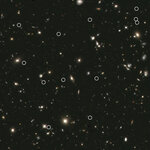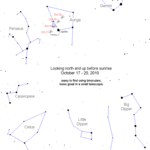Space

Like our own world history, the Universe had its own cycle of events. After the initial Big Bang (though 'Bang' is a confusing word, it may have been rather dull), there were no light sources in the Universe. Instead, 370,000 years after the Big Bang electrons and protons combined to form neutral hydrogen gas and released the radiation presently observed as the cosmic microwave background (CMB), so stars and galaxies formed in a kind of cosmic 'Dark Ages' (sans invading barbarians) but those early star-forming galaxies produced enough ultraviolet radiation to ionize most of…

Astronomers say they have found evidence of an intense warming period in the Universe’s early history, which they describe as a form of 'cosmic climate change'.
The findings were made by researchers measuring the temperature of gas that lies in between galaxies and they say they found a clear indication that the temperature of this 'intergalactic medium' had increased steadily between the period when the Universe was one tenth of its current age and the point at which it reached one quarter of its current age.
They speculate that the effect was caused by quasars; giant accreting black holes…
National Geographic's Space Photos This Week is akin to dangling a shiny object in front of a kitten - the kitten may not knowledgeably be able to discuss the refractive index of said object, but it can think "oooh, pretty"1 and play with it contentedly.
I am not any kind of expert on space, but I can look at the photos of jellyfish-lookalike planetary nebula and think "oooh, pretty" and share them with you.
This photo was taken by Hubble of the planetary nebula NGC 6210, about 6,500 light-years away from Earth in the constellation Hercules. Planetary nebulae are the clouds of dust and gas…
Last year, DPR AmSci Journal wrote about a great new citizen science program called Citizen Sky [read from August 26, 2009]. This project is collecting observational data on the current eclipsing of the variable binary star system epsilon Aurigae. The primary star is estimated to be 300 times the diameter of our Sun, and the eclipsing object orbits at about the equivalent distance of Neptune from the Sun.
Discovered in 1821 by Johann Fritsch, the system has continued to be a mystery with its odd 27-year eclipsing cycle coupled with a 600+ day eclipse, which has been increasing in length…

49 light years away from Earth in the constellation Lyra is a binary star that may cause a rethink on how gas giant planets were created.
The researchers used astrometry which, like every method in cosmology, has a checkered past (and present - see Gliese 581g) regarding bold discoveries of previously unknown planets. In 1963, Peter van de Kamp of Swarthmore College's Sproul Observatory, announced that, based on his astrometry analysis, the faint, red star called Barnard's Star, six light years away and 20% of the mass of our Sun (and the largest angular motion across the…

I enjoy a good romp in the hay as much as the next space scientist, and I'd love to go to Mars, so it's nice to see that researchers are tackling both issues simultaneously. Further, there are few things as satisfying as a good review article. A review article is one that simply summarizes the current thinking and theories on a topic. In this case, the topic is Sex on Mars.
The article title is "Sex on Mars". A basic truth, well stated. It's subtitle is "Pregnancy, Fetal Development, and Sex In Outer Space", by Rhawn Joseph, Ph.D. (BRL, Emeritus). It appears in the Journal of Cosmology…

When a NASA rocket slammed into the Moon last fall, scientists knew they would get information about the composition of the lunar soil at the poles that has never been sampled. The findings from that NASA mission, called LCROSS for Lunar CRater Observing and Sensing Satellite, are out, and they are interesting to say the least.The emptied upper stage of a rocket crashed into the Cabeus crater near the Moon's south pole last October. A second spacecraft followed to analyze the ejected debris for signs of water and other constituents of the super-chilled lunar landscape.
In one of the new…

Astronomers report they have measured the distance to the most remote galaxy and have found that they are seeing it when the Universe was only about 600 million years old (a redshift of 8.6), making those the first confirmed observations of a galaxy whose light is clearing the opaque hydrogen fog that filled the cosmos at this early time.
“Using the ESO Very Large Telescope we have confirmed that a galaxy spotted earlier using Hubble is the most remote object identified so far in the Universe” , says Matt Lehnert (Observatoire de Paris) who is lead author of the paper reporting the…

Is stating 'DIY' and 'Craft' redundant? Perhaps, but the main story is about the cooler, hipper NASA teaming up with Etsy. The premise: make a NASA-y shuttle-related artwork or handicraft and you can both sell it and win prizes. They even use a pun for the title: "NASA and Etsy present the 2010 Space Craft Contest"
You can even sell your work... but then you have to be able to recreate it if you win the 'will fly it on the Space Shuttle' prize. There's over 360 submissions already, with all entries due by November 2, 2010. You don't have to have an Etsy shop (though…

Skimming by Earth as close as 11 million miles on October 20, the apparently young Hartley 2 comet will be nearly visible to the unaided eye. With binoculars, it will appear even better as a fuzzy, green blob, and a backyard telescope will offer excellent viewing.
The next several days should be busy mornings for amateur astronomers, and will also be a great time foranyone to do some easy viewing of a special celestial event.
Head outside while it is still dark before sunrise, and look upward to the north. Passing through the constellation Auriga will be an unusual green blip…